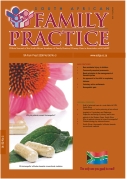An Approach to the Child in Respiratory Distress
Keywords:
Respiratory diseases, paediatric, pneumonia
Abstract
Respiratory distress (RD), a term utilised to summate a conglomeration of clinical features, including tachypnoea, use of accessory muscles of respiratory, lower chest wall indrawing, grunting, hypoxaemia and cyanosis, is useful in determining severity of illness in childhood. While these features commonly reflect pathology in the respiratory system, a condition accounting for the vast majority of the 10.8 million under-five childhood deaths occurring globally each year, dysfunction in other organ systems may also present with features of respiratory distress. The World Health Organization (WHO) has utilised some of these clinical findings to classify the severity of pneumonia and to advocate management under its programme of integrated management of childhood illness. The WHO has identified the following three essential steps that would help reduce mortality from pneumonia: (1) recognition of a sick child, (2) appropriate seeking of care, and (3) management of the underlying condition. Despite the WHO’s acknowledgement that appropriate implementation of these steps would have a significant impact on reaching the target of Millennium Development Goal 4 (a two-thirds reduction in the global under-five mortality rates between 1990 and 2015), only about one in five health caregivers knows the danger signs of severe respiratory distress, inappropriate behaviour in seeking care is often seen in the impoverished, poorly educated communities, and effective interventions are inconsistently applied.
Section
CPD
By submitting manuscripts to SAFP, authors of original articles are assigning copyright to the South African Academy of Family Physicians. Copyright of review articles are assigned to the Publisher, Medpharm Publications (Pty) Ltd, unless otherwise specified. Authors may use their own work after publication without written permission, provided they acknowledge the original source. Individuals and academic institutions may freely copy and distribute articles published in SAFP for educational and research purposes without obtaining permission.

